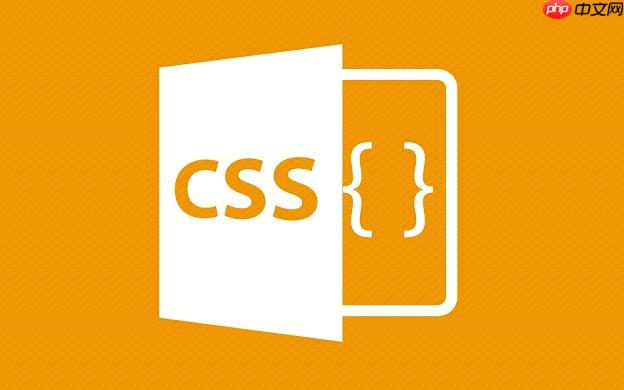答案:通过font-family回退链和@font-face嵌入字体,结合font-display:swap与WOFF2格式、子集化、CDN缓存等优化手段,确保字体加载性能与视觉一致性。

当CSS中指定的字体在用户系统上缺失时,浏览器会智能地回退到
font-family
解决方案 核心的解决方案围绕着两个主要策略:
font-family
@font-face
font-family
font-family: "Custom Font", Arial, sans-serif;
使用@font-face
@font-face {
font-family: 'MyAwesomeFont'; /* 你为字体选择的名称 */
src: url('fonts/myawesomefont.woff2') format('woff2'),
url('fonts/myawesomefont.woff') format('woff');
font-weight: normal;
font-style: normal;
font-display: swap; /* 对用户体验至关重要 */
}
body {
font-family: 'MyAwesomeFont', 'Helvetica Neue', Arial, sans-serif;
}在这里,
font-display: swap
swap
swap
woff2
woff
woff2
构建一个健壮的字体回退堆栈,不仅仅是简单地列出几个字体名称,它更像是在设计一个视觉上的容错机制。我通常会从最理想的、你希望用户看到的字体开始,然后逐步向后退,直到一个通用字体族。
我的思考过程是这样的:
立即学习“前端免费学习笔记(深入)”;
@font-face
Arial
Helvetica Neue
Verdana
Georgia
Times New Roman
Helvetica Neue
Arial
serif
sans-serif
monospace
cursive
fantasy
sans-serif
serif
一个实际的例子可能看起来像这样:
body {
font-family: 'Open Sans', 'Helvetica Neue', Arial, sans-serif;
}
h1 {
font-family: 'Merriweather', Georgia, 'Times New Roman', serif;
}这里,
Open Sans
Merriweather
@font-face
Helvetica Neue
Arial
sans-serif
Georgia
Times New Roman
serif
@font-face
font-display
font-display
@font-face
它有几个主要值:
auto
block
block
swap
fallback
swap
optional
最佳实践: 对于绝大多数情况,特别是正文和标题,我强烈建议使用
font-display: swap;
举个例子:
@font-face {
font-family: 'BrandHeaderFont';
src: url('fonts/brandheaderfont.woff2') format('woff2');
font-weight: bold;
font-style: normal;
font-display: swap; /* 确保标题文本快速可见 */
}
@font-face {
font-family: 'IconFont'; /* 比如一些SVG图标字体 */
src: url('fonts/iconfont.woff2') format('woff2');
font-weight: normal;
font-style: normal;
font-display: optional; /* 如果图标字体加载慢,回退到其他图标或空白,不影响主要内容 */
}通过选择合适的
font-display
自定义字体虽然能极大提升网站的视觉表现力,但如果处理不当,也可能成为页面加载速度的瓶颈。在我看来,优化字体加载是一个多方面的工作,涉及到文件格式、子集化、异步加载等技术。
使用现代字体格式(WOFF2):
woff2
woff
TTF
OTF
woff2
woff
@font-face {
font-family: 'OptimizedFont';
src: url('fonts/optimizedfont.woff2') format('woff2'),
url('fonts/optimizedfont.woff') format('woff'); /* WOFF for older browsers */
/* ... other properties ... */
}尽量避免直接使用
TTF
OTF
字体子集化(Subsetting): 一个完整的字体文件通常包含了几千甚至上万个字符,包括各种语言、符号、数字等。但我们的网站可能只需要用到其中的一小部分。字体子集化就是移除那些不必要的字符,只保留你网站实际使用的字符集(比如只保留英文字母、数字和常用标点)。这能将字体文件大小大幅缩减。 例如,如果你的网站只显示英文内容,就没有必要加载完整的包含中文、日文等字符的字体文件。一些在线工具(如 Font Squirrel 的 Webfont Generator)或本地工具(如
fonttools
按需加载(unicode-range
unicode-range
@font-face {
font-family: 'MyChineseFont';
src: url('fonts/mychinesefont.woff2') format('woff2');
unicode-range: U+4E00-9FFF, U+FE30-FFA0; /* 常用中文字符范围 */
}
@font-face {
font-family: 'MyEnglishFont';
src: url('fonts/myenglishfont.woff2') format('woff2');
unicode-range: U+0000-007F; /* 基本拉丁字符 */
}这样,如果页面内容只包含英文字符,浏览器就不会下载
MyChineseFont
CDN 加载和缓存: 将字体文件托管在CDN上,可以利用CDN的全球分布式网络,让用户从离他们最近的服务器获取字体,从而加快下载速度。同时,设置合适的HTTP缓存头(
Cache-Control
预加载(preload
<link rel="preload" as="font" crossorigin>
<link rel="preload" href="fonts/myawesomefont.woff2" as="font" type="font/woff2" crossorigin>
但要注意,不要滥用
preload
通过这些方法,我们可以在享受自定义字体带来的视觉优势的同时,最大限度地减少其对网站性能的影响。这不仅仅是
以上就是CSS怎么补字体_CSS缺失字体回退与自定义字体设置教程的详细内容,更多请关注php中文网其它相关文章!

每个人都需要一台速度更快、更稳定的 PC。随着时间的推移,垃圾文件、旧注册表数据和不必要的后台进程会占用资源并降低性能。幸运的是,许多工具可以让 Windows 保持平稳运行。

Copyright 2014-2025 https://www.php.cn/ All Rights Reserved | php.cn | 湘ICP备2023035733号